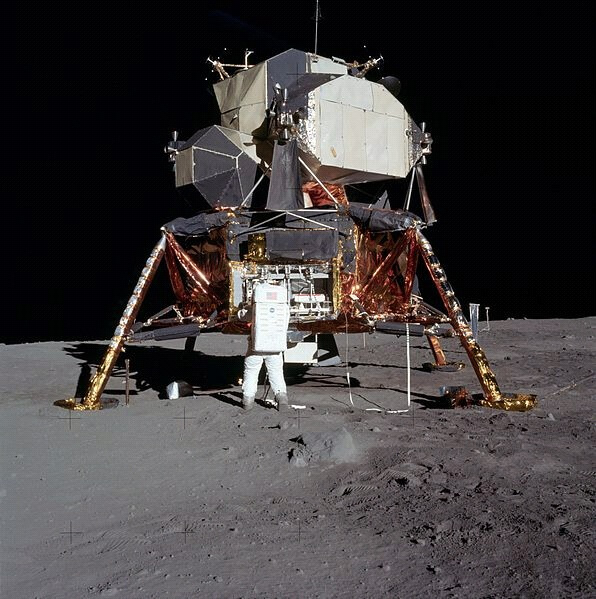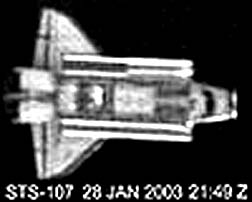This Friday at 18:26 (Israel time), the space shuttle will take off for the last time. When we watch the launch we will have to realize with sorrow that we are looking at history that will not return. It remains to be hoped that the next big step will come soon

According to an old joke, a camel is a horse designed by a committee. In this respect the space shuttle is a kind of camel. Although it was not designed by a committee, it is not what it was supposed to be, and not what the elected officials approved for NASA to build. It was designed for the wrong reasons, for the wrong purposes and without an adequate budget. And all because they managed to land on the moon.
Edwin "Buzz" Aldrin and the Apollo 11 lunar landing module
In July 1969, Apollo 11 landed on the moon and effectively achieved the goal of the Apollo program. The US space agency continued to launch more missions to the moon, but the public's interest in the space program was declining, and the US House of Representatives decided to stop funding. The Apollo 17 flight in 1972 sealed the lunar program.
In the seventies there was little presence of astronauts in space: 3 missions to the Skylab space station (1973-1974) and the Apollo-Soyuz mission (1975), a meeting in orbit of an American spacecraft and a Russian spacecraft.
During these years, the space shuttle development project was already underway, but it was not until 1981 that development matured and manned space missions resumed.
The amazing part, and the sad part in hindsight, is that at the beginning of the journey the ferry was not the destination at all.
The destination was Mars. The manned flight to Mars was intended to replace the Apollo program's place in the public consciousness, and a cheap way was needed to get crews back and forth to a space station that would be mounted in low orbit around the Earth, so that from there they could set off for Mars. But something else caught the administration's attention in its seventieth year - the Vietnam War. The American government did not consider it reasonable to send people to Mars in the middle of a war, and the huge budgets required for the Vietnam War caused the elimination of the Mars program, which has not been revived to this day.
In those years, since the end of the moon landing missions, public interest in the space program was waning, and NASA needed a big project. Shuttles whose sole purpose is to service the space station would not receive funding from the House of Representatives and would not arouse public interest. The one who came to the aid of the agency was the US Air Force, which at the time had its own space program. The Corps abandoned its plans for manned space missions, but still needed a platform to launch the large imaging satellites.
The help didn't come for free, of course. Although NASA funded most of the development, it had to invest an additional budget to develop a shuttle that the Air Force could use, which was much larger than the original design (about 4 times longer!).
The budget for the shuttle project started with a little more than 13 billion dollars, but at a certain point during the work, it was reduced to only 5.5 billion dollars. To cope with the cut, planning changes were required; For example, instead of a rocket booster that should release the shuttle at sub-orbital altitude, and return to landing using air-breathing engines (similar to aircraft engines), a non-recyclable rocket launcher and two boosters that can be returned to service after a round of repairs are developed.
The result of the design changes, the budget reduction and the changes as a result of the reduction was a horribly expensive vehicle to operate and maintain. As a direct result of this, the planned rate of launches was affected. When President Nixon approved the space shuttle program, he was told that the rate of launches would be slightly less than once a week (close to 50 launches a year). In reality, due to the high cost of launching each shuttle, the pace was immeasurably slow. In the record year of shuttle launches, 1985, only 9 launches were made.
Shortly after, on January 28, 1986, the shuttle Challenger exploded during launch, taking with it the first of the two crews of seven astronauts lost in that program. While the Challenger disaster eliminated the notion that the space shuttle was an operational tool for putting people into orbit as a 'routine' matter, the Columbia shuttle disaster in 2003 (one of whose crew members was Israeli astronaut Ilan Ramon) practically buried the shuttle program.

Even though the space shuttle is one of the most complicated machines ever built by man, a chance of a catastrophic failure of 2 out of about 130 missions is completely unacceptable. In addition, a program that has cost the American taxpayer 175 billion dollars to date, and the cost of each of its flights is 1.5 billion dollars, cannot have such low reliability.
These are the main reasons why the space shuttle era must end. Although great scientific and technological achievements were achieved through it, it was never the vehicle that the original idea's minds dreamed of.
The American government decided to stop the shuttle program and replace it with a safer and cheaper program, while encouraging private companies to enter the space launch business. The results can be seen already. Several private companies have begun to promote initiatives that will bring people into space already in the next year or two, although not yet at a "popular" price. In private hands it is likely to be more efficient and cheaper, and since the insurance companies will have something to say, the launching companies will also be forced to prove that their launches are much safer. Maybe in not many years it will be possible to fly to the route on a commercial flight and at a price that is not very high.
This Friday at 18:26 (Israel time), the space shuttle will take off for the last time. When we watch the launch we will have to realize with sorrow that we are looking at history that will not return. It remains to be hoped that the next big step will come soon.
____________________________
Credit for all images: NASA
Originally posted on the blog critical mass

7 תגובות
Yoel.
thanks a lot for the answer.
This is actually one of the first things I thought of
But I wasn't sure, and the reason is that there would be tension between the nations.
But apparently the Cold War era has thawed greatly and will not return again.
Have a good week everyone.
The Hal station will be reached after the age of shuttles by means of the Russian Soyuz space vehicle, which has been serving the Russian cosmonauts for 40 years.
The Soyuz-type rocket and the cabin on top of which the cosmonauts sit have proven their efficiency and safety for many years.
It is possible that in the near future the Russians will start launching the Soyuz rockets from the European space base located in French Guinea in South America.
The reason for this is that launching rockets into space from the equatorial region is cheaper than launching them from other regions on Earth.
That is, the amount of energy needed to launch a rocket into space near the equator is less than launches at more northern or southern sites.
Sorry for the ignorance, but I must have missed something.
How exactly will they get to the space station?????????
And in general, what is the future of the space station???
I would be very happy to receive an answer.
Thanks in advance.
The ferries are not that dangerous. In both disasters, NASA knew that there was a special risk (in Challenger, severe weather at the launch site, in Columbia, a crack in the heat insulator), and preferred to remain silent. Probably human life is not worth too much effort...
https://www.hayadan.org.il/images/content3/2011/07/bazz_aldrin_and_moon-modul.jpg
It will be many, many years, if at all, until the next time the USA sends people to Jericho.
Reflections on the decline of Empire.